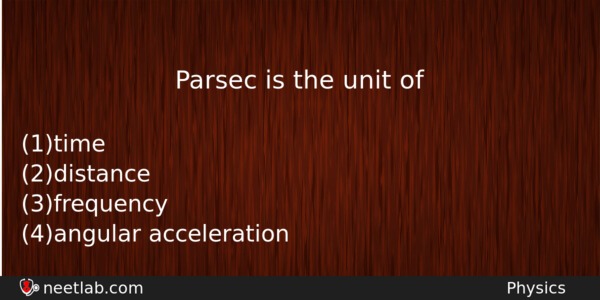

Parsec unit derivation software#
used CFX commercial software to numerically simulate the three-dimensional transient flow field inside the hydrodynamic torque converter, compared the differences between the one-dimensional flow beam theory, steady-state calculation, transient calculation, and the test results, and used transient simulation to analyze the flow behavior of the unsteady flow field at the pump exit and turbine inlet for a period of time.
Parsec unit derivation code#
used 3D computer code to calculate the three-dimensional flow field inside the torque converter and analyzed the mechanisms of centrifugal force, pressure gradients, shear force, Coriolis, and other parameters’ effects on the internal flow field. proposed to use the three-dimensional non-orthogonal curvilinear coordinate system to express the complex geometric shape of the cascade of the hydrodynamic torque converter and carried out computational fluid dynamics (CFD) three-dimensional flow field calculations. With developments in technology, a numerical simulation based on three-dimensional flow has been rapidly developed and applied. In the later stages, the hydrodynamic loss coefficient needs to be revised through experiments, which greatly extends the design cycle. The assumptions of non-viscous fluid are very different from real three-dimensional flow. However, the one-dimensional flow beam theory has made many assumptions, such as replacing the three-dimensional flow with design streamline and ignoring the number of blades and the thickness of the blades.

One-dimensional flow beam theory has the advantages of clear design ideas, easy operation, and being fast. In the past, constrained by developments in technology, Eulerian one-dimensional flow beam theory has become the mainstream design method for the torque converter cascade. The new parametric design method of the blade shape and the integrated optimization design system of a three-dimensional cascade of torque converter proposed in this paper significantly reduces the design costs and shortens the design cycle of the torque converter, which will provide a valuable reference for engineers of turbomachinery. Compared with the original blade, the optimized NURBS blade increased by 7.207% in high-efficiency region width ( G η), and the optimized blade increased by 2.673% in peak efficiency ( η max) to meet the actual engineering requirements. Finally, multi-objective optimization was carried out for the key cascade parameters (camberline peak height).

A three-dimensional cascade integrated optimization design system of the hydrodynamic torque converter is established with CFD technology as the bottom layer design, a control file as the middle layer, and an optimization algorithm as the top layer drive.

Then, the author developed batch and script files in the Isight platform for a fully automated integrated design of the hydrodynamic torque converter, including cascade parametric modeling, meshing, computational fluid dynamics (CFD) simulation, post-processing, and optimization design. The method is embodied by using a cubic non-uniform rational B-splines (NURBS) open curve and closed curve, respectively, to carry out the parametric design of the unit blade camberline and unit blade thickness distribution, and the curvature of the designed blade curve is continuous. Therefore, the study proposed a new parametric design method for a hydrodynamic torque converter cascade. Advanced cascade design theories and methods are crucial to the rapid development of torque converters.


 0 kommentar(er)
0 kommentar(er)
